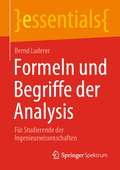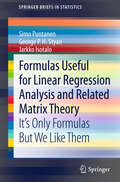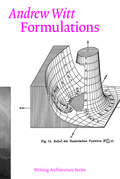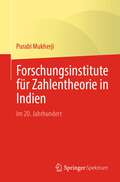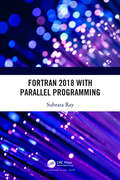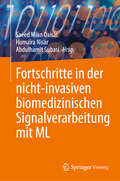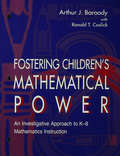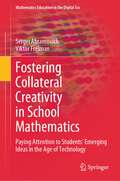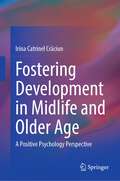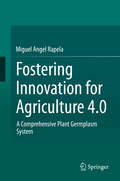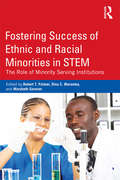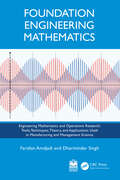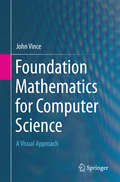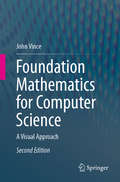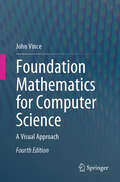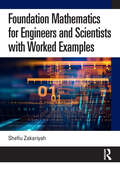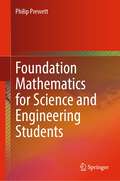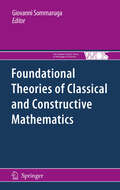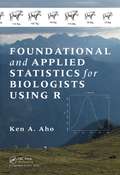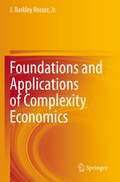- Table View
- List View
Formeln und Begriffe der Analysis: Für Studierende der Ingenieurwissenschaften (essentials)
by Bernd LudererDie wichtigsten mathematischen Formeln und Begriffe aus dem Gebiet Analysis für Studierende der Ingenieurwissenschaften und verwandter Richtungen werden präsentiert. Dieses essential ist nützlich als Ergänzung zum Studium, beim Selbststudium, als Nachschlagewerk zum täglichen Gebrauch und in der Klausur. Enthalten ist in übersichtlicher Weise alles Wichtige zu komplexen Zahlen, Definition und Eigenschaften zahlreicher Funktionen, Differenzial- und Integralrechnung, einschließlich Doppel- und Dreifachintegrale, sowie gewöhnlichen Differenzialgleichungen.
Formulas Useful for Linear Regression Analysis and Related Matrix Theory: It's Only Formulas But We Like Them
by Simo Puntanen George P. Styan Jarkko IsotaloThis is an unusual book because it contains a great deal of formulas. Hence it is a blend of monograph, textbook, and handbook.It is intended for students and researchers who need quick access to useful formulas appearing in the linear regression model and related matrix theory. This is not a regular textbook - this is supporting material for courses given in linear statistical models. Such courses are extremely common at universities with quantitative statistical analysis programs.
Formulation of Uncertainty Relation Between Error and Disturbance in Quantum Measurement by Using Quantum Estimation Theory
by Yu WatanabeIn this thesis, quantum estimation theory is applied to investigate uncertainty relations between error and disturbance in quantum measurement. The author argues that the best solution for clarifying the attainable bound of the error and disturbance is to invoke the estimation process from the measurement outcomes such as signals from a photodetector in a quantum optical system. The error and disturbance in terms of the Fisher information content have been successfully formulated and provide the upper bound of the accuracy of the estimation. Moreover, the attainable bound of the error and disturbance in quantum measurement has been derived. The obtained bound is determined for the first time by the quantum fluctuations and correlation functions of the observables, which characterize the non-classical fluctuation of the observables. The result provides the upper bound of our knowledge obtained by quantum measurements. The method developed in this thesis will be applied to a broad class of problems related to quantum measurement to build a next-generation clock standard and to successfully detect gravitational waves.
Formulations: Architecture, Mathematics, Culture (Writing Architecture)
by Andrew WittAn investigation of mathematics as it was drawn, encoded, imagined, and interpreted by architects on the eve of digitization in the mid-twentieth century.In Formulations, Andrew Witt examines the visual, methodological, and cultural intersections between architecture and mathematics. The linkages Witt explores involve not the mystic transcendence of numbers invoked throughout architectural history, but rather architecture&’s encounters with a range of calculational systems—techniques that architects inventively retooled for design. Witt offers a catalog of mid-twentieth-century practices of mathematical drawing and calculation in design that preceded and anticipated digitization as well as an account of the formal compendia that became a cultural currency shared between modern mathematicians and modern architects. Witt presents a series of extensively illustrated &“biographies of method&”—episodes that chart the myriad ways in which mathematics, particularly the mathematical notion of modeling and drawing, was spliced into the creative practice of design. These include early drawing machines that mechanized curvature; the incorporation of geometric maquettes—&“theorems made flesh&”—into the toolbox of design; the virtualization of buildings and landscapes through surveyed triangulation and photogrammetry; formal and functional topology; stereoscopic drawing; the economic implications of cubic matrices; and a strange synthesis of the technological, mineral, and biological: crystallographic design. Trained in both architecture and mathematics, Witt uses mathematics as a lens through which to understand the relationship between architecture and a much broader set of sciences and visual techniques. Through an intercultural exchange with other disciplines, he argues, architecture adapted not only the shapes and surfaces of mathematics but also its values and epistemic ideals.
Forschend durch Haus und Garten: Mathematische und naturwissenschaftliche Experimente für die ganze Familie
by Matthias Müller Christina WaltherDieses Buch lädt mit 20 „alltäglichen“ Experimenten die ganze Familie zum Forschen und Entdecken im häuslichen Umfeld ein: Die teils offenen Fragen fordern zu genauem Beobachten und systematischer Auseinandersetzung mit den mathematischen und naturwissenschaftlichen Zusammenhängen auf; die Erkenntnisse und die dazugehörigen wissenschaftlichen Konzepte werden im Anschluss beschrieben und eingeordnet, regen aber zugleich dazu an, eigenständig weitere Fragestellungen zu entwickeln. Den erzählerischen Rahmen bilden liebevoll geschilderte Geschichten, die Menschen jeden Alters zu einem aufmerksamen und forschenden Blick im eigenen Alltag ermutigen. Denn ob in Küche, Bad oder Garten: Wer mit offenen Augen durch die Welt geht, wird überall spannende Forschungsobjekte finden und entsprechende Fragen stellen – egal, ob es um perfekte Stöpsel, leuchtende Pflanzen oder nimmervolle Fässer geht. Die beschriebenen Experimente können zuhause mit alltäglichen bzw. leicht zu beschaffenden Gegenständen und Materialien durchgeführt werden; sie wurden im Rahmen des Schülerforschungszentrums in Jena praktisch erprobt und evaluiert. Die vorgeschlagene Entdeckungsreise kann allein oder auch gemeinsam mit der Familie (Geschwister, Eltern, Großeltern etc.) unternommen werden.
Forschend durch Haus und Garten: Mathematische und naturwissenschaftliche Experimente für die ganze Familie
by Matthias Müller Christina WaltherDieses Buch lädt mit 23 „alltäglichen&“ Experimenten die ganze Familie zum Forschen und Entdecken im häuslichen Umfeld ein: Den erzählerischen Rahmen bilden liebevoll geschilderte Geschichten, die Menschen jeden Alters zu einem aufmerksamen und forschenden Blick im eigenen Alltag ermutigen. Denn ob in Küche, Bad oder Garten – wer mit offenen Augen durch die Welt geht, wird überall spannende Forschungsobjekte finden und entsprechende Fragen stellen. Egal, ob es um perfekte Stöpsel, leuchtende Pflanzen oder nimmervolle Fässer geht, es warten spannende Fragen und Entdeckungen im Alltag. Die teils offenen Fragen fordern zu genauem Beobachten und systematischer Auseinandersetzung mit den zugrundeliegenden mathematischen und naturwissenschaftlichen Zusammenhängen auf. Die selbstgewonnenen Erkenntnisse können mit den beschriebenen wissenschaftlichen Konzepten verglichen werden, was zugleich dazu anregt, eigenständig weitere Fragestellungen zu entwickeln. Die beschriebenen Experimente können zuhause mit alltäglichen bzw. leicht zu beschaffenden Gegenständen und Materialien durchgeführt werden; sie wurden im Rahmen des Schülerforschungszentrums in Jena praktisch erprobt und evaluiert. Die vorgeschlagene Entdeckungsreise kann allein oder auch gemeinsam mit der Familie (Geschwister, Eltern, Großeltern etc.) unternommen werden. Für die zweite, überarbeitete Auflage sind drei Fragestellungen sowie die zugehörigen Beschreibungen der Experimente hinzugekommen. Freuen Sie sich also auf drei neue Entdeckungen zwischen Küche und Wohnzimmer!
Forschungsinstitute für Zahlentheorie in Indien: Im 20. Jahrhundert
by Purabi MukherjiDieses Buch versucht, die schrittweise Entwicklung der wichtigsten Forschungsinstitute zur Zahlentheorie in Südindien, Punjab, Mumbai, Bengalen und Bihar zu beschreiben, einschließlich der Gründung des Tata Institute of Fundamental Research (TIFR) in Mumbai, einem bahnbrechenden Ereignis in der Geschichte der Zahlentheorie-Forschung in Indien. Die Forschung zur Zahlentheorie in Indien begann in der modernen Zeit mit dem Auftreten des ikonischen Genies Srinivasa Ramanujan, das Mathematiker auf der ganzen Welt inspirierte. Das Buch diskutiert die nationale und internationale Wirkung der Forschung indischer Zahlentheoretiker und enthält eine sorgfältig zusammengestellte, umfassende Bibliographie bedeutender indischer Zahlentheoretiker des 20. Jahrhunderts. Es ist wichtig für die historische Dokumentation und eine wertvolle Ressource für Forscher auf diesem Gebiet. Das Buch diskutiert auch kurz die Bedeutung der Zahlentheorie in der modernen Mathematik, einschließlich Anwendungen der Ergebnisse indigener Zahlentheoretiker in praktischen Bereichen. Da das Buch aus der Perspektive der Wissenschaftsgeschichte geschrieben ist, wurden technische Fachbegriffe und mathematische Ausdrücke so weit wie möglich vermieden.Die Übersetzung wurde mit Hilfe von künstlicher Intelligenz durchgeführt. Eine anschließende menschliche Überarbeitung erfolgte vor allem in Bezug auf den Inhalt.
Forschungsmethoden in Psychologie und Sozialwissenschaften für Bachelor
by Margrit Schreier Gerald Echterhoff Walter Hussy Jana F. Bauer Nicole WeydmannDieses Lehrbuch bietet einen leichten Einstieg und verständlichen Gesamtüberblick über die quantitativen und qualitativen Methoden der Psychologie und angrenzender Sozialwissenschaften: alle wichtigen Verfahren, ihre Logik und Einsatzgebiete, Stärken und Schwachpunkte und auch neuere Entwicklungen. Methoden sind das Fundament der Psychologie und aller Sozialwissenschaften und deshalb allgegenwärtig im Studium. Doch das Thema weckt bei manchen auch Sorgen, insbesondere wenn unter Zeit- und Erfolgsdruck gelernt werden muss. Aber: Keine Angst vor den Forschungsmethoden! Die 3. Auflage wurde vollständig überarbeitet und enthält Fallbeispiele, Definitionen, Tipps für die Praxis, Lernziele, Kontrollfragen und vertiefende Literatur. Lern-Tools für Studierende sowie Abbildungen und Foliensätze zum Download für Dozierende finden sich darüber hinaus auf www.lehrbuch-psychologie.springer.com.
Fortran 2018 with Parallel Programming
by Subrata RayThe programming language Fortran dates back to 1957 when a team of IBM engineers released the first Fortran Compiler. During the past 60 years, the language had been revised and updated several times to incorporate more features to enable writing clean and structured computer programs. The present version is Fortran 2018. Since the dawn of the computer era, there had been a constant demand for a “larger” and “faster” machine. To increase the speed there are three hurdles. The density of the active components on a VLSI chip cannot be increased indefinitely and with the increase of the density heat dissipation becomes a major problem. Finally, the speed of any signal cannot exceed the velocity of the light. However, by using several inexpensive processors in parallel coupled with specialized software and hardware, programmers can achieve computing speed similar to a supercomputer. This book can be used to learn the modern Fortran from the beginning and the technique of developing parallel programs using Fortran. It is for anyone who wants to learn Fortran. Knowledge beyond high school mathematics is not required. There is not another book on the market yet which deals with Fortran 2018 as well as parallel programming. FEATURES Descriptions of majority of Fortran 2018 instructions Numerical Model String with Variable Length IEEE Arithmetic and Exceptions Dynamic Memory Management Pointers Bit handling C-Fortran Interoperability Object Oriented Programming Parallel Programming using Coarray Parallel Programming using OpenMP Parallel Programming using Message Passing Interface (MPI) THE AUTHOR Dr Subrata Ray, is a retired Professor, Indian Association for the Cultivation of Science, Kolkata.
Fortschritte in der nicht-invasiven biomedizinischen Signalverarbeitung mit ML
by Abdulhamit Subasi Saeed Mian Qaisar Humaira NisarDieses Buch präsentiert Fortschritte in der biomedizinischen Technologie. IoT und Machine Learning haben neue Ansätze im mobilen Gesundheitswesen ermöglicht, mit Fokus auf kontinuierlicher Überwachung kritischer Gesundheitssituationen. Intelligente Hybridisierung von IoT, drahtlosen Implantaten und Cloud-Computing wird derzeit von verschiedenen Einrichtungen entwickelt und getestet. Biomedizinische Signale und Bildmodalitäten werden nicht-invasiv erfasst und erfordern eine mehrkanalige Erfassung für wirksame Überwachung. Automatisierte Gesundheitssysteme basieren auf Signal- und Bildaufnahme, Vorverarbeitung, Merkmalsextraktion und Klassifikation. Das Buch beschreibt zeitgenössische Ansätze in der biomedizinischen Signalerfassung und -verarbeitung mit maschinellem und tiefem Lernen. Jedes Kapitel ist eigenständig und bietet eine umfassende Übersicht über Theorien, Algorithmen und Herausforderungen im Bereich moderner Gesundheitssysteme.
Fostering Children's Mathematical Power: An Investigative Approach To K-8 Mathematics Instruction
by Ronald T. Coslick Arthur J. BaroodyTeachers have the responsibility of helping all of their students construct the disposition and knowledge needed to live successfully in a complex and rapidly changing world. To meet the challenges of the 21st century, students will especially need mathematical power: a positive disposition toward mathematics (curiosity and self confidence), facility with the processes of mathematical inquiry (problem solving, reasoning and communicating), and well connected mathematical knowledge (an understanding of mathematical concepts, procedures and formulas). This guide seeks to help teachers achieve the capability to foster children's mathematical power - the ability to excite them about mathematics, help them see that it makes sense, and enable them to harness its might for solving everyday and extraordinary problems. The investigative approach attempts to foster mathematical power by making mathematics instruction process-based, understandable or relevant to the everyday life of students. Past efforts to reform mathematics instruction have focused on only one or two of these aims, whereas the investigative approach accomplishes all three. By teaching content in a purposeful context, an inquiry-based fashion, and a meaningful manner, this approach promotes chilren's mathematical learning in an interesting, thought-provoking and comprehensible way. This teaching guide is designed to help teachers appreciate the need for the investigative approach and to provide practical advice on how to make this approach happen in the classroom. It not only dispenses information, but also serves as a catalyst for exploring, conjecturing about, discussing and contemplating the teaching and learning of mathematics.
Fostering Collateral Creativity in School Mathematics: Paying Attention to Students’ Emerging Ideas in the Age of Technology (Mathematics Education in the Digital Era #23)
by Viktor Freiman Sergei AbramovichThis book explores the topic of using technology, both physical and digital, to motivate creative mathematical thinking among students who are not considered ‘mathematically advanced.’ The book reflects the authors’ experience of teaching mathematics to Canadian and American teacher candidates and supervising several field-based activities by the candidates. It consists of eight chapters and an Appendix which includes details of constructing computational learning environments.Specifically, the book demonstrates how the appropriate use of technology in the teaching of mathematics can create conditions for the emergence of what may be called ‘collateral creativity,’ a notion similar to Dewey’s notion of collateral learning. Just as collateral learning does not result from the immediate goal of the traditional curriculum, collateral creativity does not result from the immediate goal of traditional problem solving. Rather, mathematical creativity emerges as a collateral outcome of thinking afforded by the use of technology. Furthermore, collateral creativity is an educative outcome of one’s learning experience with pedagogy that motivates students to ask questions about computer-generated or tactile-derived information and assists them in finding answers to their own or the teacher’s questions. This book intends to provide guidance to teachers for fostering collateral creativity in their classrooms.
Fostering Development in Midlife and Older Age: A Positive Psychology Perspective
by Irina Catrinel CrăciunThis handbook integrates and discusses a growing evidence base concerning individual development across middle and late adulthood. The book includes a comprehensive analysis of what growth implies within midlife and older age and considers how different developmental areas are intertwined (i.e., physical, cognitive, social and emotional development as well as personality growth). As the gap between theory and practice still constitutes an issue in developmental research, the handbook also aims to provide illustrative examples of prevention and intervention from a positive psychology perspective. These were selected to represent a variety of topics, relevant for individual development where research informs practice, ranging from happiness, grandparenthood, love and sexuality to loneliness, depression, anxiety, suicide prevention and coping with death. This handbook is a must-have resource for students and researchers working in developmental psychology, health psychology, gerontology and, public health. It will also be of interest to practitioners such as counsellors, life coaches, psychotherapists, organizational psychologists, health professionals, social workers or public health planners.
Fostering Innovation for Agriculture 4.0: A Comprehensive Plant Germplasm System
by Miguel Angel RapelaThe scientific and technical development of any kind of germplasm is regulated by a vast network of treaties, conventions, international agreements, and national and regional legislation. These regulations govern biotechnological innovations in plants and microorganisms, access to and use of plant genetic resources, and biosafety. This complex mix has made it difficult to arrive at global interpretations, due to overlaps, gaps, ambiguities, contradictions, and lack of consistency. The big picture is even more complex, as a series of scientific developments – gene editing in particular – have in some cases rendered these international regulatory frameworks obsolete.This book puts forward an innovative approach: a “Comprehensive Plant Germplasm System”. The System is a cooperative game theory-based proposal for a binding international convention which would supersede all other conventions, treaties, national and regional legislation covering native varieties and traditional developments, heterogeneous plant varieties, microorganisms, biotechnological inventions, plant genetic resources, and biosafety regulation. In short, it offers a comprehensive framework regarding intellectual property, biosafety, and business regulation and covers all types of germplasm.If applied, the system is expected to yield higher productivity rates in crops and improved food biodiversity, as well as a new paradigm based on the promotion of innovation for “Agriculture 4.0.”
Fostering Success of Ethnic and Racial Minorities in STEM: The Role of Minority Serving Institutions
by Dina C. Maramba Marybeth Gasman Robert T. PalmerTo maintain competitiveness in the global economy, United States policymakers and national leaders are increasing their attention to producing workers skilled in science, technology, engineering, and mathematics (STEM). Given the growing minority population in the country, it is critical that higher education policies, pedagogies, climates, and initiatives are effective in promoting racial and ethnic minority students’ educational attainment in STEM. Minority Serving Institutions (MSIs) have shown efficacy in facilitating the success of racial and ethnic minority students in STEM and are collectively responsible for producing nearly one-third of the nation’s minority STEM graduates. In Fostering Success of Ethnic and Racial Minorities in STEM, well-known contributors share salient institutional characteristics, unique aspects of climate, pedagogy, and programmatic initiatives at MSIs that are instrumental in enhancing the success of racial and ethnic minority students in STEM education. This book provides recommendations on institutional practice, policy, and lessons that any institution can use on their campus to foster better retention and persistence among minority students. Higher Education leaders and administrators interested in encouraging achievement among racial and ethnic minority students in STEM education will find this book a welcomed and timely addition to the discourse on promoting minority student success.
Foundation Engineering Mathematics (Engineering Mathematics and Operations Research)
by Faridon Amdjadi Dharminder SinghMathematics plays a central role in modern culture, and a basic understanding of the nature of mathematics is required for scientific literacy. This new textbook will prepare readers to continue to develop analytical and numerical skills through the study of a variety of mathematical techniques. The statistical element of this textbook enhances the readers’ ability to organize and interpret data. Most of the topics covered in this textbook are widely used in various areas of engineering, including industrial engineering, to analyze complex systems, optimize processes and make informed decisions to improve efficiency, productivity and reliability in various industrial settings.From the complexities of double integration and ordinary differential equations to the complexities of linear systems of differential equations, Fourier series and Laplace transform, Foundation Engineering Mathematics unfolds with careful attention to detail, offering readers a structured approach to mastering these fundamental topics. Each chapter book is carefully presented to provide a balance between theoretical foundations and practical applications, ensuring that readers not only grasp the underlying principles but also appreciate their relevance in real-world engineering scenarios. Each chapter is accompanied by practical examples, illustrative diagrams and engineering applications to reinforce understanding and demonstrate the relevance of mathematical concepts in engineering practice.Whether you're a student embarking on your journey into the world of mathematics or a experienced engineer seeking to deepen your understanding of mathematical concepts, this book serves as an invaluable resource, guiding you through the complexities of mathematical theory and its engineering applications.A solutions manual and a set of PowerPoint slides are available for qualified textbook adoptions.
Foundation Mathematics for Computer Science
by John VinceJohn Vince describes a range of mathematical topics to provide a foundation for an undergraduate course in computer science, starting with a review of number systems and their relevance to digital computers, and finishing with differential and integral calculus. Readers will find that the author's visual approach will greatly improve their understanding as to why certain mathematical structures exist, together with how they are used in real-world applications. Each chapter includes full-colour illustrations to clarify the mathematical descriptions, and in some cases, equations are also coloured to reveal vital algebraic patterns. The numerous worked examples will consolidate comprehension of abstract mathematical concepts. Foundation Mathematics for Computer Science covers number systems, algebra, logic, trigonometry, coordinate systems, determinants, vectors, matrices, geometric matrix transforms, differential and integral calculus, and reveals the names of the mathematicians behind such inventions. During this journey, John Vince touches upon more esoteric topics such as quaternions, octonions, Grassmann algebra, Barycentric coordinates, transfinite sets and prime numbers. Whether you intend to pursue a career in programming, scientific visualisation, systems design, or real-time computing, you should find the author's literary style refreshingly lucid and engaging, and prepare you for more advanced texts.
Foundation Mathematics for Computer Science: A Visual Approach
by John VinceIn this second edition of Foundation Mathematics for Computer Science, John Vince has reviewed and edited the original book and written new chapters on combinatorics, probability, modular arithmetic and complex numbers. These subjects complement the existing chapters on number systems, algebra, logic, trigonometry, coordinate systems, determinants, vectors, matrices, geometric matrix transforms, differential and integral calculus. During this journey, the author touches upon more esoteric topics such as quaternions, octonions, Grassmann algebra, Barrycentric coordinates, transfinite sets and prime numbers. John Vince describes a range of mathematical topics to provide a solid foundation for an undergraduate course in computer science, starting with a review of number systems and their relevance to digital computers, and finishing with differential and integral calculus. Readers will find that the author’s visual approach will greatly improve their understanding as to why certain mathematical structures exist, together with how they are used in real-world applications. This second edition includes new, full-colour illustrations to clarify the mathematical descriptions, and in some cases, equations are also coloured to reveal vital algebraic patterns. The numerous worked examples will help consolidate the understanding of abstract mathematical concepts. Whether you intend to pursue a career in programming, scientific visualisation, artificial intelligence, systems design, or real-time computing, you should find the author’s literary style refreshingly lucid and engaging, and prepare you for more advanced texts.
Foundation Mathematics for Computer Science: A Visual Approach
by John VinceIn this book, John Vince has reviewed and edited the third edition and added chapters on statistics, Georg Riemann’s hypothesis, eigen vectors, curves, analytic geometry and Fourier analysis. These subjects complement the existing chapters on visual mathematics, numbers, algebra, logic, combinatorics, probability, modular arithmetic, trigonometry, coordinate systems, determinants, vectors, complex numbers, matrices, geometric matrix transforms, differential and integral calculus. During this journey, the author touches upon more esoteric topics such as quaternions, octonions, Grassmann algebra, barycentric coordinates, transfinite sets and prime numbers. John Vince describes a range of mathematical topics that provide a solid foundation for an undergraduate course in computer science, starting with a review of number systems and their relevance to digital computers and finishing with calculating area and volume using calculus. Readers will find that the author’s visual approach should greatly improve their understanding as to why certain mathematical structures exist, together with how they are used in real-world applications. This book includes new, full-colour illustrations to clarify the mathematical descriptions, and in some cases, equations are also coloured to reveal vital algebraic patterns. The numerous worked examples will help consolidate the understanding of abstract mathematical concepts. Whether you intend to pursue a career in programming, scientific visualization, artificial intelligence, systems design or real-time computing, you should find the author’s literary style refreshingly lucid and engaging and prepare you for more advanced texts.
Foundation Mathematics for Engineers and Scientists with Worked Examples
by Shefiu ZakariyahFoundation Mathematics for Engineers and Scientists with Worked Examples covers fundamental topics in mathematics required for science and engineering disciplines. It is primarily designed to provide a comprehensive, straightforward and step-by-step presentation of mathematical concepts to engineers, scientists and general readers. It moves from simple to challenging areas, with carefully tailored worked examples of different degrees of difficulty. Mathematical concepts are deliberately linked with appropriate engineering applications to reinforce their value and are aligned with topics taught in major overseas curriculums. This book is written primarily for students at levels 3 and 4 (typically in the early stages of a degree in engineering or a related discipline) or for those undertaking foundation degree, Higher National Certificate (HND), International Foundation Year (IFY), and International Year One (IYO) courses with math modules. It consists of seven parts: Basic concepts in Mathematics Coordinate Geometry Algebraic Expression and Equations Surds Indices and Logarithms Polynomials Trigonometry Each chapter is devoted to a topic and can be used as a stand-alone guide with no prior knowledge assumed. Additional exercises and resources for each chapter can be found online. To access this supplementary content, please go to www.dszak.com.
Foundation Mathematics for Science and Engineering Students
by Philip PrewettThis compact textbook provides a foundation in mathematics for STEM students entering university. The book helps students from different disciplines and backgrounds make the transition to university. Based on the author’s teaching for many years, the book can be used as a textbook and a resource for lecturers and professors. Its accessibility is such that it is can also be used by students in their final year in school before university and help them continue their mathematical studies at college. The book is designed so that students will return to the book repeatedly as their undergraduate careers progress. Although compact and concise, it loses no rigour. All the topics are carefully explained meaningfully, not just presented as a set of rules or rote-learned procedures.
Foundation Mathematics for the Physical Sciences
by M. P. Hobson K. F. RileyThis tutorial-style textbook develops the basic mathematical tools needed by first and second year undergraduates to solve problems in the physical sciences. Students gain hands-on experience through hundreds of worked examples, self-test questions and homework problems. Each chapter includes a summary of the main results, definitions and formulae. Over 270 worked examples show how to put the tools into practice. Around 170 self-test questions in the footnotes and 300 end-of-section exercises give students an instant check of their understanding. More than 450 end-of-chapter problems allow students to put what they have just learned into practice. Hints and outline answers to the odd-numbered problems are given at the end of each chapter. Complete solutions to these problems can be found in the accompanying Student Solutions Manual. Fully-worked solutions to all problems, password-protected for instructors, are available at www. cambridge. org/foundation.
Foundational Theories of Classical and Constructive Mathematics
by Giovanni SommarugaThe book "Foundational Theories of Classical and Constructive Mathematics" is a book on the classical topic of foundations of mathematics. Its originality resides mainly in its treating at the same time foundations of classical and foundations of constructive mathematics. This confrontation of two kinds of foundations contributes to answering questions such as: Are foundations/foundational theories of classical mathematics of a different nature compared to those of constructive mathematics? Do they play the same role for the resp. mathematics? Are there connections between the two kinds of foundational theories? etc. The confrontation and comparison is often implicit and sometimes explicit. Its great advantage is to extend the traditional discussion of the foundations of mathematics and to render it at the same time more subtle and more differentiated. Another important aspect of the book is that some of its contributions are of a more philosophical, others of a more technical nature. This double face is emphasized, since foundations of mathematics is an eminent topic in the philosophy of mathematics: hence both sides of this discipline ought to be and are being paid due to.
Foundational and Applied Statistics for Biologists Using R
by Ken A. AhoFull of biological applications, exercises, and interactive graphical examples, Foundational and Applied Statistics for Biologists Using R presents comprehensive coverage of both modern analytical methods and statistical foundations. The author harnesses the inherent properties of the R environment to enable students to examine the code of complica
Foundations and Applications of Complexity Economics
by J. Barkley Rosser, Jr.This book presents a survey of the aspects of economic complexity, with a focus on foundational, interdisciplinary ideas. The long-awaited follow up to his 2011 volume Complex Evolutionary Dynamics in Urban-Regional and Ecologic-Economic Systems: From Catastrophe to Chaos and Beyond, this volume draws together the threads of Rosser’s earlier work on complexity theory and its wide applications in economics and an expanded list of related disciplines. The book begins with a full account of the broader categories of complexity in economics--dynamic, computational, hierarchical, and structural--before shifting to more detailed analysis. The next two chapters address problems associated with computational complexity, especially those of computability, and discuss the Godel Incompleteness Theorem with a focus on reflexivity. The middle chapters discuss the relationship between entropy, econophysics, evolution, and economic complexity, respectively, with applications in urban and regional dynamics, ecological economics, general equilibrium theory, as well as financial market dynamics. The final chapter works to bring together these themes into a broader framework and expose some of the limits concerning analysis of deeper foundational issues.With applications in all disciplines characterized by interconnected nonlinear adaptive systems, this book is appropriate for graduate students, professors and practitioners in economics and related disciplines such as regional science, mathematics, physics, biology, environmental sciences, philosophy, and psychology.
